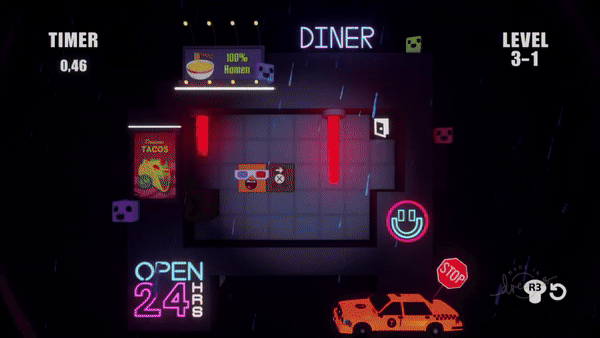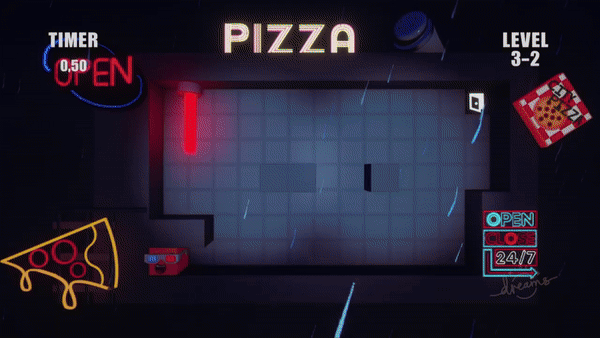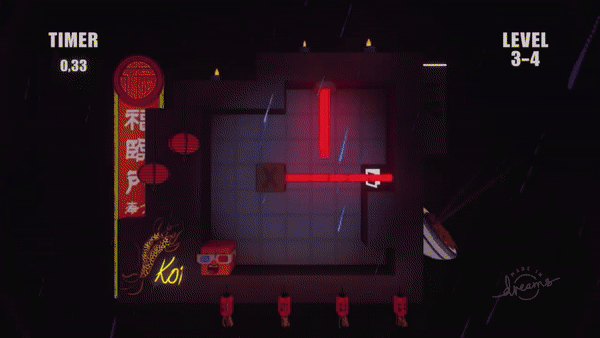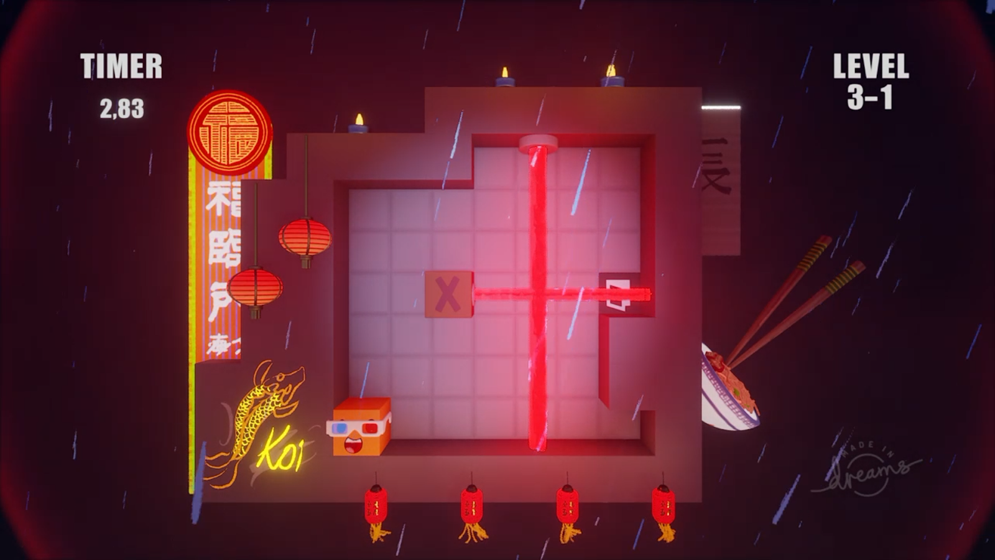
SQUARE ESCAPE
Solo Project | Engine: Dreams | Development Time: 2 Months | Responsibilities: Level and Puzzle Design, Mechanics, and UI
OVERVIEW
Square Escape is a strategy puzzle game where players control a square, navigating through various themed levels by pushing boxes and manipulating the environment to reach the end goal.
Game Link: https://indreams.me/dream/mQbdFSBVhEH
Scroll Down for Screenshots & Process
PLAYTHROUGH VIDEO
SCREENSHOTS
DESIGN PILLARS
Simple & Accessible
Mechanic Depth & Versatility
The controls are designed to be simple and intuitive, allowing players to move in four directions and push boxes with ease.
The game’s straightforward mechanics make it accessible to a wide audience, including casual gamers and puzzle enthusiasts.
Progressive Difficulty
New mechanics and obstacles are introduced progressively through the stages allowing players to learn and adapt without being overwhelmed.
Each level builds on the previous ones, reinforcing learned mechanics and gradually increasing the complexity of puzzles.
Engaging Level Design
The game features distinct themed stages (Jungle, Beach, City), each introducing unique mechanics and visual aesthetics.
Levels are designed to challenge the player’s problem-solving skills, with a mix of straightforward and complex puzzles.
Ensure each game mechanic is rich in depth, providing multiple uses to enhance gameplay complexity and player engagement.
Design each mechanic to serve more than one purpose within the game. For example, boxes not only block lasers but can also be used to create paths over water
PROCESS
CONCEPTUALIZING
My inspirations for this game were Sokoban and Lara Croft GO. While Sokoban influenced the core mechanics of pushing boxes and solving spatial puzzles, Lara Croft GO inspired the thematic elements and varied obstacles like lasers and water. I aimed to blend these influences, adding my unique spin to create a fresh and engaging puzzle experience.
PROTOTYPING
In the initial prototyping phase, I focused on implementing the core mechanics of player movement and box pushing. This foundational step was crucial for establishing the basic interactions and gameplay flow.
During the development of the box-pushing mechanic, I encountered an unexpected bug: when the player was positioned between two boxes, both boxes would move simultaneously. Rather than viewing this as a problem, I saw an opportunity to enhance the gameplay. I decided to lean into the bug and transform it into a deliberate game mechanic, adding an extra layer of strategy and complexity to the puzzles.
This approach to prototyping allowed me to quickly iterate on the core mechanics and adapt to unexpected challenges, ultimately leading to a more dynamic and engaging gameplay experience.

SKETCHING AND LEVEL DESIGN
In this phase, I focused on conceptualizing and designing the levels for Square Escape. Even though the game was ultimately developed in Dreams, the initial level design process started on paper.
I began by sketching out potential levels on paper. This helped me quickly iterate on ideas and visualize each puzzle's overall layout and flow. I cut out small paper squares representing the player and the other game elements to better understand and test the movements and interactions within each level.
This approach was useful for visualizing complex movements and interactions. By physically moving the paper squares, I could more easily see the sequence of actions required to solve each puzzle.


FEEDBACK AND ITERATION
Since the early stages of development, I have consistently conducted playtests with family, friends, and colleagues to refine and iterate on the puzzles and pacing of the game.
As the project progressed, I also had the opportunity to test the game with random players, which proved to be extremely helpful. Their feedback was particularly valuable due to its honesty and fresh perspective.
Based on the feedback received, I made several iterations. I adjusted the order of some levels, increased the box movement speed to better match the player's movement speed, and had to create additional levels to ensure a smoother transition between some of the levels

That's me

POLISHING
After solidifying the core mechanics and iterating through multiple prototypes, the polishing phase began. This stage was essential to ensure the game felt cohesive, engaging, and enjoyable for players.
Enhanced visual cues for player actions, such as box movement and interactions with obstacles like lasers and water. This included adding animations and particle effects to make actions more satisfying.
Polished the in-game UI to provide clear and concise information to the player, including a timer, level indicators, and control prompts.
MECHANIC DEPTH AND VERSATILITY
I designed each mechanic to serve more than one purpose within the game.
For example, the lasers in my game can be found static, moving, rotating, temporary, or even attached to boxes.
STATIC

MOVING

ROTATING

TEMPORARY

ATTACHED TO BOX

CLOSING THOUGHTS
What went right
Iterative Playtesting: Conducting playtests early and frequently with family, friends, colleagues, and eventually random people helped refine puzzles, pacing, and mechanics.
Embracing Bugs: The initial bug where pushing one box caused two to move was turned into a unique mechanic, adding an unexpected layer of strategy to the game.
Less is More: Focusing on a few core mechanics and expanding them to their full capacity proved successful. Rather than overwhelming players with numerous mechanics, this strategy allowed for deeper exploration and more creative puzzle designs.

What went wrong
Pacing Issues: Initially, some levels felt disjointed in difficulty progression. This was addressed by reordering levels and creating intermediary stages to smooth the transition.
Balancing Challenge: Finding the right balance between challenging and frustrating was difficult. Some puzzles had to be reworked multiple times to hit the sweet spot where players felt rewarded without feeling overwhelmed.



















